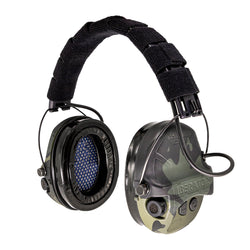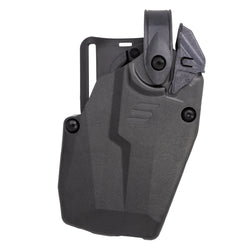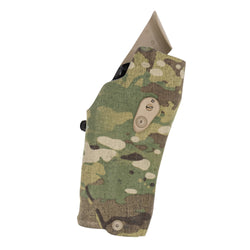I’m partial to shotguns—specifically defensive or fighting shotguns. Why? Well, when it comes to shoulder-fired weapons and power per trigger pull, it doesn’t get much better than the shotgun.
The United States has always been more partial to shotguns than other nations, which shows in the heavy use of shotguns by police and military forces. Admittedly, shotguns have taken a backseat to the carbine in the current era of police work and have always been a niche tool in the military world.

Still, they can’t completely disappear. The fighting shotgun continues to fill critical roles. It’s been used to clear trenches, fight in jungles, fire less-lethal munitions, breach doors, and now it’s one of the best on-the-ground tools for killing small drones.
Fighting shotguns have evolved, and those various evolutions have taken on different names over time.
They’ve been called coach guns, trench guns, riot guns, and tactical shotguns. Today, we’ll break down those terms and explain the differences between these fighting shotguns.
The World of Fighting Shotguns
Shotguns adapt, and as they evolve for different roles, their names tend to change. However, the name isn’t the only thing that changes. We also changes in actions, accessories, and even ammunition.
Fighting shotguns remain relevant due to their ability to change. Today, we’ll focus on the four most prominent types of fighting shotguns from the modern era. Let’s look at what they are, their relevance, and how they’re designed.
Coach Gun
Coach guns were some of the original modern fighting shotguns. The name comes from their use on horse-drawn stagecoaches—specifically those operated by Wells Fargo.
The bank had to send coaches through lawless parts of the West, and between 1870 and 1884, almost 350 robbery attempts were recorded. To help protect cargo and the lives of drivers, they assigned a guard carrying a coach gun.

Coach guns were double-barrel fighting shotguns. Typically, they were 12 gauge, but 10 gauge and 16 gauge versions weren’t unheard of. The barrels were short, around 18 inches, but I wouldn’t be shocked to hear shorter or slightly longer. The guns were often hammer-fired, but hammerless variants certainly existed.
These guns were light and short, easy to maneuver and swing. Although they may have only held two rounds, the spread of the shot helped guarantee hits from a bumpy stagecoach while fighting off moving targets.
Aiming was definitely needed, but you were more likely to hit your threat. The double-barrel design allowed for two rapid-fire shots.

Coach guns almost exclusively refer to double-barrel guns. However, if you read some old literature, you may see references to the Winchester 1887, a lever-action shotgun, as a coach gun.
If one was ever used as a coach gun, the term may have been applied simply due to a specific gun’s short length.
The Riot Gun
Riot guns are pump-action fighting shotguns. One of the earliest examples is the Winchester 1897. Winchester produced a riot version from 1897 up into the 1950s.
Riot guns were typically aimed at police use, but military forces would go on to adopt various riot guns over the ages. As the name implies, riot guns were meant for riots and other large-scale crimes where a sidearm simply wouldn’t work.

Interestingly, the term “riot gun” first originated in 1886 in a newspaper from Indiana describing a short double-barrel shotgun used to quell rioters. Riot guns would fire rounds less likely to kill rioters, and birdshot was often used at longer ranges to control rioters. A popular tactic was to fire birdshot at an angle against the ground to bounce it into the rioter’s legs.
Over time, riot guns became standard equipment in police cruisers. These were pump-action shotguns with short 18–20 inch barrels and no magazine plugs, typically holding 4–5 rounds.

Due to their simplicity and design, most police shotguns can easily be classified as riot guns. The famed Stakeout Squad of New York City and Holloway’s Raiders successfully employed riot guns.
The Trench Gun
Trench guns were created in response to World War 1. Trench warfare proved brutal, and fights often devolved into close-range shooting. Shotguns excelled at close-quarters fights, and trench guns evolved for the purpose.
The first and most famous trench gun was the Winchester 1897. Trench guns remained in military service long after World War 1, and Winchester also produced the last U.S. military trench gun—the Winchester 1200. Winchester created the first trench gun, so it’s only appropriate that they made the last.

Trench guns were made by most commercial shotgun manufacturers, including Remington, Winchester, Stevens, and more.
Trench guns were typically pump-action repeaters with short barrels, heat shields, and bayonet mounts. In close-quarters trench warfare, a bayonet was a must. Heat shields protected the support hand during bayonet use—especially important since barrels heated quickly in combat.

Mounting a bayonet was a necessity. Fighting shotgun barrels get hot, and if you’re bayonet fighting, you’re likely to grab the top of the barrel. The heat shield protected your hands while you fought with the bayonet. Rifles of the era used wood handguards over the barrel, but shotguns mostly adopted a wood or metal mesh-like design.
While trench warfare declined after WWI, these guns remained in military armories and American minds for decades.
The Tactical Shotgun
“Tactical shotgun” is the catch-all term for today’s fighting shotguns. These are typically pump or semi-auto designs, and these days, most are semi-auto.
Police, military forces, and civilian defenders all make use of modern tactical shotguns. The most common barrel length is 18.5 inches, but 20 inches isn’t uncommon, and even the shorter 14-inch variants aren’t unheard of. Depending on magazine tube length, capacity can range from four to nine rounds.

Most modern tactical shotguns are designed to be accessorized and somewhat modular. Weapon-mounted lights, red dots, and other accessories are not uncommon. Sighting systems will often be beads, but ghost rings are another popular option.

Tactical shotguns are fielded for a variety of tasks. There is the typical buckshot bad guy remover, but they can fire less lethal ammo as well. Breaching is a popular tactical shotgun role, and in the last few years, they have been the go-to drone destroyer.
Fighting Shotguns and You
Fighting shotguns continue to evolve. Every time it seems like they are about to fade away, they are called back to action.
The design flexibility and raw effectiveness of the shotgun make sure it’s never out of the fight for long.









